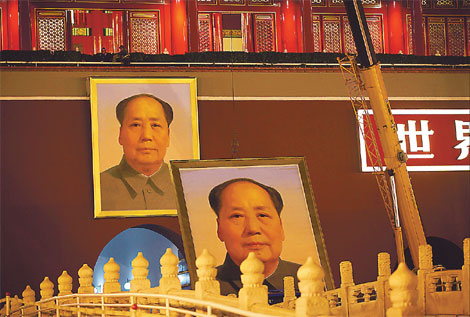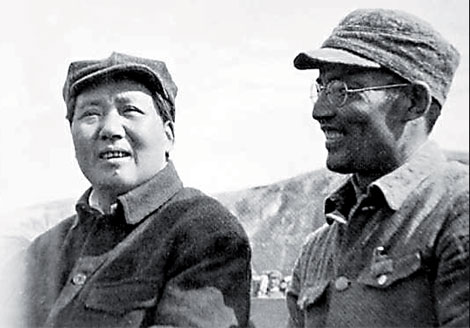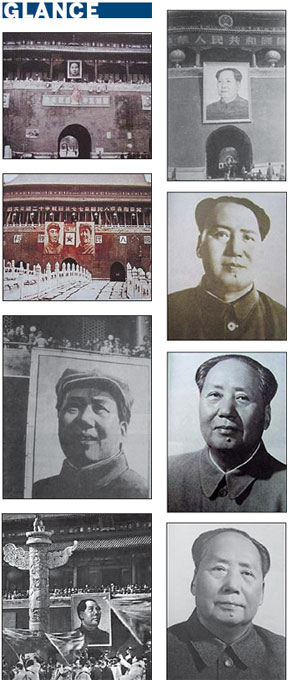| Radiology Room |
| Ultrasound Room |
| Surgery Room |
| Laboratory Room |
| Comprehensive Room |
| Pediatrics Room |
| Dental Room |
| Medical operation instruments |
| Hospital Furniture |
| Medical supplies |
News Center
Face of 'heavenly peace'
 |
|
An old portrait of Chairman Mao Zedong is replaced by a new one on Sept 27 for National Day. [Photo by Chen Xiaogen / For China Daily] |
In the early decades of the founding of New China, the portrait image of Chairman Mao Zedong on Tian'anmen Rostrum was changed eight times. Liu Yujie reports.
Looking at the portrait of Chairman Mao smiling down on the hordes of visitors to the Forbidden City, it is hard to imagine that the Great Helmsman's picture was once just one of many on the Tian'anmen Rostrum. Or even that several versions of his photograph have graced the nation's most iconic landmark.
But the truth is, in the early decades of the founding of the People's Republic of China, Mao's picture was changed eight times.
Before 1966, Mao's portrait went up on the rostrum just twice a year - around May 1 and Oct 1, for about 10 days each time.
Yan Shujun, 46, a soldier-turned-collector of Tian'anmen memorabilia, who has a number of photographs of the rostrum, says: "I find the change of Chairman Mao's pictures on Tian'anmen Rostrum very interesting as they reflect the nation's changing political and social scenarios."
It was from the Tian'anmen Rostrum that emperors of yore announced important messages to their people.
Yan's collection shows that in 1949, when New China was founded, the portraits on the rostrum were changed three times.
On Feb 12, Beiping (as Beijing was then known) celebrated its liberation, and eight portraits of leaders, including Mao Zedong, Zhu De, Lin Biao, Nie Rongzhen and Ye Jianying, were displayed on the rostrum. This is the only time that so many leaders' portraits were hung together.
Chen Ruoju, 83, was one of the students of Beiping Art School (BAS), who volunteered to work on those portraits. His professor Dong Xiwen (1914-1973) did the main portraits, while the students were in charge of decorating the frame's borders.
"I remember we were so excited that we kept at it for days with little rest."
On July 7, two big smiling portraits, one of Mao and the other of Zhu, then the nation's highest military leader, appeared side by side with a red star in between, to mark the 12th anniversary of the Marco Polo Bridge Incident that marked the beginning of the eight-year War of Resistance against Japanese Aggression. These too were done by teachers and students from BAS.
"The arrangement (of the portraits) reflected the intimate and solid relationship between Mao and Zhu - jointly they defeated enemies that were larger and much better equipped. Without each other, they couldn't have won success," Yan said.
Zhou Lingzhao, 92, who was a teacher at BAS at that time, created the third version of Mao, which was used for the founding ceremony of PRC on Oct 1, 1949. He said Mao wanted his picture to show a more natural expression.
Zhou was asked to paint from a photo that Mao himself favored. It captures the moment when Mao was taking an early morning walk along a river in Yan'an with Zhu Rui, a senior military official, who was killed in battle a year before the founding ceremony.
"I heard that Chairman Mao shed tears when he picked up the photo and decided to have his smiling face in that photo enlarged for portrait painting," Zhou said.
After weeks of work on the huge canvas, sans magnifier, Zhou and his team finally completed "the largest handmade portrait in the Eastern Hemisphere", 6 meters tall, 4.6 meters wide, and weighing 1.5 tons, a day before the founding ceremony.
 |
|
This image of Chairman Mao taken with Zhu Rui in Yan'an, Shaanxi province, was enlarged for the portrait painting at Tian'anman Rostrum, for the founding ceremony on Oct 1, 1949. [Photo provided to China Daily] |
Thus, on day one of the new country, this is how Mao's portrait looked - smiling naturally, and wearing an octagonal cap.
The following five versions of Mao, however, did away with the cap. "The cap was part of the Red Army's uniform and was deemed unsuitable for a leader of a big state," Yan said.
It was a photo of Mao and Joseph Stalin used by US media on Mao's first visit to the then Soviet Union on Dec 16, 1949, that triggered the call for a standardized version of Mao's portrait.
In that picture, Stalin, in his handsome marshal's uniform, came across as domineering and arrogant, while Mao cut a lackluster picture in his plain cotton suit. "The contrast was so obvious that we quickly realized we needed a new image of Chairman Mao to reflect the energy and confidence of New China," Yan said.
A group of artists headed by Xin Mang (1916-2007), at Beijing People's Art Studio, took over the task and created the first portrait of a cap-free Mao, the fourth version of his portrait to grace Tian'anmen Rostrum on May 1, 1950. But that too attracted criticism, on the grounds that in it Mao was not exactly looking ahead, only his right ear was seen, and his eyes were turned upwards. Critics said these aspects could be interpreted as, "Chairman Mao does not care for the people and listens to only one side". The portrait was soon taken down.
 |
|
The eight versions of Chairman Mao's portrait that hung on the Tian'anman Rostrum in the early decades of the founding of the People's Republic of China. [Photo provided to China Daily] |
Wang, who refuses to give interviews, once told Yan, the collector, that painting a portrait of Mao to the satisfaction of all parties was no mean task.
He said, in the first place, a suitable expression of Mao had to be picked from hundreds and thousands of photos. However, painting from just a photo could not capture all the nuances. Wang remembers taking advantage of opportunities to assist at the airport, to observe Mao as he welcomed foreign leaders. He would try to commit the leader's facial expressions and body language to memory, calling them up later to make his paintings more vivid.
"I tried to enliven Mao's face with a hint of his amiability and sharpness," he told Yan.
The portrait for the rostrum is so huge that it also puts tremendous physical strain on the painters, who had to examine the overall effect constantly from afar. "The mouth, or an eye, could be as long as one meter. Traditional techniques just do not work," Wang said.
The clever man and his team found that by using a magnifier the other way around, they could get an idea of how the portrait looked from afar.
In 1976, a deeply sorrowful Wang painted Mao, who died on Sept 9, one last time.
Soon after, he retired.
In 1977, his most talented and hardworking students, Ge Xiaoguang and Liu Yang, took over the job. For 33 years now, Ge has been painting a new portrait of Mao based on the version created by Wang to be hung on the rostrum before National Day.
Ge's painting is considered to be so true to life that whichever way you turn, Mao appears to be watching you, smiling.
Liu Yang, who also paints other great Socialist thinkers and leaders such as Karl Marx, Friedrich Engels and Vladimir Lenin, held an exhibition of his portraits at Military Museum of Chinese People's Liberation Army in 2009 to mark the 60th anniversary of China's founding.
"Painting giant portraits of great men is a rare skill that deserves to be passed on. I'm doing this not only because I enjoy it, but also because I don't want this art to stop in my generation," Liu said.
Even though the number of Mao portraits and statues nationwide has reduced sharply, China's late leader Deng Xiaoping once told Oriana Fallaci, the Italian journalist famed for her political interviews, in 1980, that Mao's portrait was an integral part of the Tian'anmen Rostrum, and would remain forever.
本文由廣州佳譽醫(yī)療器械有限公司編輯






